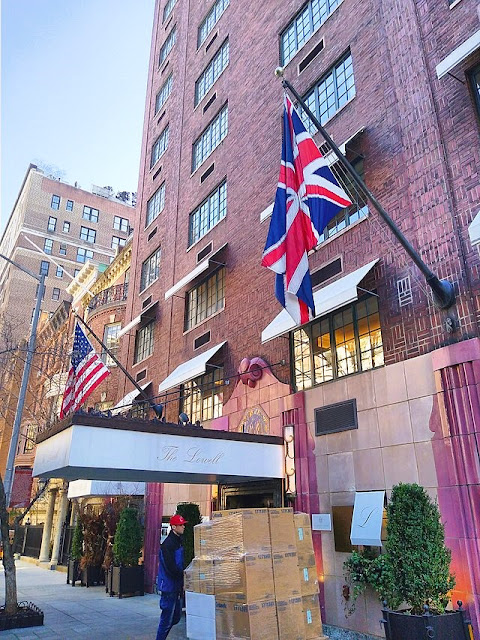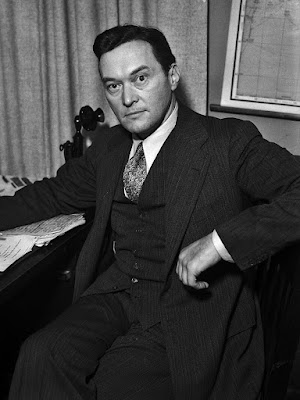photo by Jim Henderson
When Leo H. Wise purchased 30 East 63rd Street in June 1916, he had lived in the high-stooped brownstone next door at 28 West 63rd Street since 1890. The Record & Guide advised he "will alter the house into a modern American basement dwelling." Instead, in 1925 he purchased 32 West 63rd Street. On September 2, the New York Evening Post reported that Wise would erect "a fifteen-story apartment hotel" designed by Henry S. Churchill on the site of the three vintage houses. "The structure will have suites of two, three and four rooms and every living room will have a wood-burning fireplace," said the article.
Completed in 1926, the upper floors of the Lowell Hotel were faced in tapestry brick, its stoic mid-section nearly unadorned. Churchill clad the single-story base in vibrant rose and cream terra cotta. Its Art Deco design included an intricate mosaic by Bertram Hartman above the entrance doors. Atop it, a terra cotta pediment rose like a crashing wave. The upper floor setbacks were decorated with cream colored terra cotta parapets and chunky Deco ornaments that acted as capitals to the long brick piers.
Architectural critic H. R. Shurtleff addressed the stark contrast between the robust, colorful base and the "common plane" of the upper floors. "Neither in material, texture, color or decorative motif is there any kinship between these two divisions." He praised Churchill for rejecting architectural conventions, saying, "What is valuable in a new form is not its degree of finish...but rather its courage in emancipating itself from an outworn formula and in attempting a new synthesis."
Because the Lowell Hotel was an apartment hotel rather than an apartment building, in March 1927 The Architectural Record explained, "No provision is made for cooking in these apartments, but a 'serving pantry' is provided for the convenience of tenants, to be used in connection with the restaurant and kitchen on the street floor." The magazine said such hotels were popular because of "the growing tendency to live longer periods of the year at summer or sea shore homes, and shorter and shorter periods in the city," adding, "It also suits a large number of business and single men or women for headquarters throughout the year, relieving them of major housekeeping worries.
Residents (and the public) could take their meals in the restaurant, entering through this Art Deco foyer. The Architectural Record, March 1927
Among the earliest tenants were playwright and screenwriter Donald Davis and his wife, Thebe Bell. The son of playwright Owen Davis, while living here he wrote for the radio show The Gibson Family, and in 1935 became involved with NBC's experimental television. Among his other works while living here were the screen plays Two Flaming Youths in 1927, Dangerous Curves in 1929, and a three-act play Nothing Matters Much in 1930. He dramatized Pearl Buck's The Good Earth for the stage with his father, then wrote the screenplay in 1937.
Even the wallpaper in the restaurant foyer was Art Deco in style. The Architectural Record, March 1927
A celebrated resident was Dorothy Parker, poet, critic, satirist and writer. According to Kevin C. Fitzpatrick in his A Journey into Dorothy Parker's New York, she moved into the Lowell Hotel following her unsuccessful suicide attempt at the Algonquin Hotel in February 1932. He notes:
After moving into the Lowell, Dottie produced some of the best short stories of her career. She would ask friends to come over and sit with her for three or four hours and force her to stay focused and keep writing.
Among those stories were Lady with a Lamp, Dusk before Fireworks, and The Waltz, all published in Harper's Bazaar or The New Yorker in 1932 and 1933.
In October 1933, New York Evening Post journalist James K. Martindale interviewed Dorothy Parker in her apartment regarding the upcoming mayoral elections. At one point the photographer snapped a photo and remarked, "That shot was no good, Miss Parker. You were squinting."
Dorothy replied, "You didn't look so good yourself."
This photograph of Dorothy Parker was taken in her Lowell Hotel apartment during the Martindale interview. New York Evening Post, October 27, 1933.
Following the death of playwright Eugene O'Neill in 1953, his widow Carlotta Monterey moved into the Lowell Hotel. Born in 1888, she went into acting following World War I. She met O'Neill in 1922 when she had a part in his play The Hairy Ape. They were married seven years later in Paris.
Director Jose Quintero visited Montery here in 1956. He told The New York Times, "It had been 10 years since any of O'Neill's works had been performed in America. He had been sentenced to oblivion, convicted of being dark, undistinguished and of no more than historical importance." The purpose of Quintero's visit was to get Monterey's permission to produce The Iceman Cometh.
It was the first of a resurgence of O'Neill's works. From her Lowell Hotel apartment, Carlotta Monterey O'Neill typed her husband's unproduced plays More Stately Mansions and Long Day's Journey Into Night, working his handwritten edits into the scripts. The latter play received the 1957 Pulitzer Prize for Drama.
Walter Lippmann and his wife, the former Helen Byrne, moved into the Lowell Hotel around 1970. The couple had married in 1938. By then, Lippmann was a well-known political journalist and author, having written A Preface to Politics in 1913 and Drift and Mastery the following year. He became a syndicated columnist for the New York Herald Tribune in 1931.
Helen was her husband's constant support. The New York Times recalled that since their marriage, she "accompanied her husband on his travels and to meetings with foreign dignitaries, learning Russian some years ago to ease his path."
On February 16, 1974, Helen Lippman suffered a heart attack "after a sudden illness at their home," reported The New York Times. She died of cardiac arrest on her way to the hospital. Walter died 10 months later, on December 14. In reporting his death, The New York Times called him, "one of the most respected and influential political writers of his time."
In June 1976, the restaurant became the Grand Cafe. Its Art Deco interiors prompted The New York Times critic John Canaday to gush, "They serve food at the Grand Cafe, a new restaurant at 28 East 63d Street, but they could serve sawdust and we would still recommend a visit, just for the decor."
In 1984, The Gruzen Partnership restored the facade and the Reynolds Partnership reworked the interiors. After the months-long renovations, the Lowell Hotel was reopened by its new owners, Lowell Hotel Associates. On January 29, The New York Times reported that the one- and two-bedroom suites, "all will have living rooms, marble bathrooms and complete kitchens. Residents will have concierge, maid and telephone-answering service, as well as meal service provided by The Post House, the ground-floor restaurant."
In its February 14, 1994 issue, New York Magazine said the Lowell Hotel "combines the atmosphere of a genteel European retreat with the warmth of a private home." It became the out-of-the-way stop-over for major celebrities like Dennis Quaid, Matt Damon (the "hip but humble manchild," as described by Rita Kempley of The Washington Post on December 31, 1999), Cybill Shepherd, and Jeremy Irons.
The Post House restaurant, described by The New York Times as "classy...commodious and masculine," occupied the ground floor space for more than two decades. It was replaced in June 2016 by Majorelle.
Tucked away on the tree-lined side street, Henry S. Churchill's Art Deco Lowell Hotel, with its forceful ground floor, is worth the side trip.
many thanks to reader Frank Regan for suggesting this post
no permission to reuse the content of this blog has been granted to LaptrinhX.com










.png)

No comments:
Post a Comment